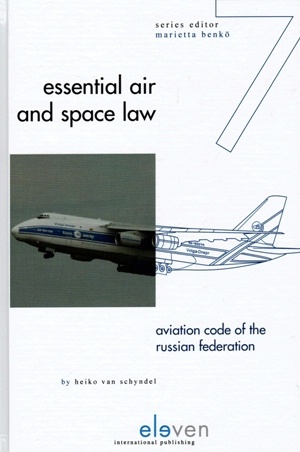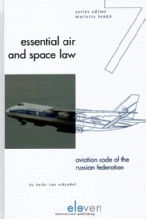Eleven International Publishing
Essential Air And Space Law - SERIES EDITOR: MARIETTA BENKÖ
Heiko van Schyndel (ed.)
THE AVIATION CODE OF THE RUSSIAN FEDERATION
This book contains the English translation and the official Russian text of the Aviation Code of the Russian Federation. For a better understanding of the Act, an introduction has been added, setting out the history of the Aviation Code and its ramifications. An outline of the Code is given and an account of other Russian Federation legislation covering the field of aviation law.
The aim of this book is to assist in presenting and clarifying the applicable aviation law in the Russian Federation by providing a professional English translation of the Russian Aviation Code. The book is a welcome addition to the literature in the field and should be of interest to anyone dealing with aviation law.
About the Author
Excerpt: CHAPTER ONE
THE GENESIS OF THE CODE
1. Historical background
Russia and its predecessor, the Soviet Union, have a long tradition and experience in aviation. The immense size of the country, the infrastructure, the lack of alternative transport modes, the remoteness of some parts of the country and its role as a super power forced the country to develop and maintain an aviation sector. In a technical sense, aviation in the Soviet Union had a good safety standard ans it has also always fulfilled its task of acting as a kind of political, economic and social glue for the country.
The Soviet Union became a member of the ICAO on 14 November 1970 and, therefore, implemented the standards and recommendations agreed by the members of that organisation, although the Soviet Union exercised its right to announce to ICAO some differences between national Soviet and international standards (e.g. the use of the metric system).
The break-up of the Soviet Union at the end of 1991 has affected its aviation structures: over 30 former area-directorates of Aeroflot, and all those based in the newly established states, became independent entities virtually overnight.
The breathtaking speed of events during this period could obviously not be matched by corresponding changes in the law and the legal framework. The Russian aviation industry, and in particular its representative "Aeroflot", faced many problems which have not been overcome easily. Some of the most important issues will be discussed below.
_______________________
(1) This chapter is based on the materials prepared by Baum / Giemulla / van Schyndel for the EC/Tacs-financed projects "Perestroika for Aeroflo"and "Legal framework for Air Transport in Russia".
1.1. The Definition of the Term "Aeroflot"
1.1.1. The Former System
The former system of civil aviation in the Soviet Union corresponded to the general structure of the state economy. The state was the only "entrepreneur" i.e. the state managed what would be considered "companies" from a Western perspective. In that sense, the entire Soviet Union was basically one immense corporation divided in state structures. Thinking in Western terms, it was therefore incorrect (at least in the area of economic activity) to call the appropriate structural units "administration" (in the sense of state administration). Individual decisions made by the state in this regard were thus not comparable to the term "administrative act" in the Western sense of the word, but were basically business, i.e. corporate decisions. The traditional administration activity of licensing was limited to a registration process (of airports, aircraft etc.). "Permits" in the Western sense of the word were not required, since the basic precondition that a certain behaviour (doing business) is independent and therefore subject to control by the authorities did not exist. As a result, the privatisation of a certain branch of the economy was basically nothing else than the privatisation of one part of the state which again meant that the appropriate administrative body then often had to be newly founded.
Civil aviation in the Soviet Union was structured as follows. The Soviet Ministry of Civil Aviation was geographically and functionally responsible for the entire civil aviation in the Soviet Union, despite the fact that the organisation was made up of more than 30 area-directorates which only carried out their activities in their appropriate region on behalf of the central organisation.
The directorates / the Ministry organised all functional areas of aviation, i.e. not only the part that would be considered "air carriers" from a Western perspective. They also administered the airports and all other facilities and institutions related to aviation, such as maintenance, air traffic control etc.
The term "Aeroflot" was therefore not a company name representing a legally independent economic entity, but rather a working term basically meaning "air fleet". Thus, the terms "civil aviation" and "Aeroflot" were used as synonyms in Article 3 Paragraph 1 of the 1983 Aviation Code of the USSR.
In order to faciliate international legal relations, this law awarded Aeroflot the status of a legal entity (only!) for international air traffic. The ensuing responsibilities were carried out by an agency located at the airport Moscow-Sheremetyevo: the "Aeroflot - Soviet Airlines Central Administration of international Air Traffic" (CUMVS-GA). The CUMVS was made up of many individual operations, such as the airport and air traffic control at the Moscow-Sheremetyevo airport, the maintenance operation and the air cargo complex.
(...)
(ESSENTIAL AIR AND SPACE LAW (SERIES EDITOR: MARIETTA BENKÖ), Volume 7: Heiko van Schyndel (ed.), The Aviation Code of the Russian Federation, Eleven International Publishing Utrecht, The Netherlands 2010, Chapter One, The Genesis of the Code, p.1-3)



